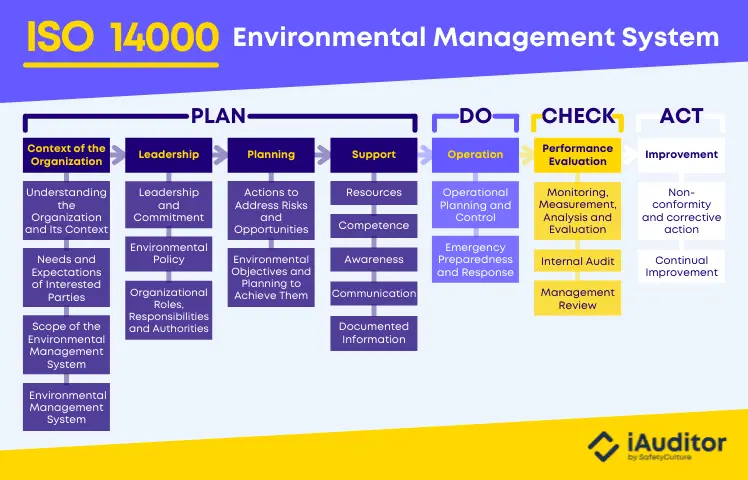What is ISO 14000?
ISO 14000 is a series of international standards designed to help organizations operate with sustainability, adhere to environmental regulations, and continuously improve processes. The ISO 14000 standard contains ISO 14001:2015 which specifies the requirements for an effective Environmental Management System (EMS).

ISO 14000: High-level Structure of Environmental Management Systems | View Fullscreen
What is an EMS?
An Environmental Management System (EMS) is a set of processes created by companies to help achieve environmental goals in a cost-effective manner. An EMS is also considered as an organizational framework designed to meet regulatory standards.
As recommended by the U.S. Environmental Protection Agency (EPA), listed below are some basic elements of an EMS:
- Reviewing the organization’s environmental goals;
- Analyzing its environmental impacts and legal requirements;
- Setting environmental objectives and targets to reduce environmental impacts and comply with legal requirements;
- Establishing programs to meet these objectives and targets;
- Monitoring and measuring progress in achieving the objectives;
- Ensuring employees’ environmental awareness and competence; and
- Reviewing progress of the EMS and making improvements.
Latest Version
The latest version of ISO 14000 is a revision of ISO 14001 published in 2015. Under the ISO 14000 family, the ISO 14001 standard details EMS criteria to effectively manage the environmental effects of their business practices.
One of the main differences between the ISO 14000 latest version and its predecessor is that ISO 14001:2015 contains an additional top-level element with a new arrangement, while ISO 14001:2004 has 6 structural elements.
ISO 14001:2015 |
ISO 14001:2004 |
| 1. Context of the Organization | 1. General |
| 2. Leadership | 2. Policy |
| 3. Planning | 3. Planning |
| 4. Support | 4. Implementation and Operation |
| 5. Operation | 5. Checking |
| 6. Performance Evaluation | 6. Management Review |
| 7. Improvement |
Related Standards
The creation of ISO 14000 in 1996 can be traced back to BS 7750, or the specification for environmental management systems, which was developed by the British Standards Institution (BSI) in 1992. Over time, certifications from the Switzerland-based International Organization for Standardization (ISO) became more recognized globally.
As the most widely adopted EMS certification, ISO 14000 is often integrated with similar standards such as the quality management system (QMS) standard, ISO 9001.
ISO 14000 and ISO 9000 are related to each other in a way that both standards deal with establishing, implementing, monitoring, and improving processes, especially for companies involved in international trade. ISO 14001 specifically focuses on environmental management, while ISO 9001 emphasizes on quality assurance programs for managing businesses.
Importance
ISO 14000 is important because it enables organizations to move beyond regulatory compliance and take a proactive approach toward environmental management. Businesses can create a massive impact when they actively take part in considering the environment—which is arguably a root of all the world’s biggest problems.
When companies systematize and standardize their operations with an internationally-accredited framework, not only can it help them implement sustainable business practices that protect the environment, but they can also inevitably achieve conformance to environmental regulations with ease.
Benefits
Certification of an EMS is entirely voluntary, but it can demonstrate credibility and reinforce an organization’s commitment to its environmental responsibilities. Here are some of the main benefits of having an ISO 14001:2015-certified EMS:
Enhanced Company Image and Brand Reputation
The initial benefit of being an ISO 14000-certified company means demonstrating excellent environmental performance and corporate citizenship. Inevitably, having a reputation for minimizing negative effects on the environment can boost corporate image, increase brand equity, and multiply customer loyalty.
Greater Conservation of Resources and Reduction of Wastes
Controlling and managing waste, effluent, and emissions are good indicators that a business is promoting environmental protection by preventing any source of pollution and contamination. With effective systems in place, natural resources, including air and water, land and precious minerals can be conserved.
Better Conformance to Legal and Other Requirements
Taking a strategic approach toward environmental management can proactively show adherence with current and future regulatory and statutory requirements. Moreover, ISO 14000 certification can result in improved health and safety outcomes through the help of an established Health, Safety, and Environment or HSE management system and its templates, reducing the risk of costly fines and litigation due to violations and complaints.
Increased Profitability, Marketability, and Sustainability
Finally, being ISO 14001:2015-certified can also provide financial gains, establish better relationships with stakeholders, and expand to different markets. Instead of companies with a high risk of environmental impact, many businesses with good environmental performance may only engage with organizations that have certified EMS frameworks.
Improve your GRC management
Simplify risk management and compliance with our centralized platform, designed to integrate and automate processes for optimal governance.
Explore nowISO 14000 Certification Process
A recent survey reported more than 300,000 valid ISO 14000 certifications across nearly half a million sites in 171 countries around the world. With the biggest growth in the entire family of ISO standards, ISO 14000 certification proves to be valuable in today’s competitive global marketplace.
While it varies based on industry sector, company size, number of sites, and available resources, listed below is a general overview of the ISO 14000 certification process:
1. Assessment by the Certifying Body
Since completing the entire process can range from anywhere between 3 months to 2 years, independent certification auditors usually carry out an assessment first. The initial assessment aims to evaluate the existing environmental management system of an organization, identify areas of improvement, and increase their readiness for the ISO 14000 certification audit.
2. Required Documentation from the Organization
In some cases, especially where a cross-functional team with adequate training oversees certification matters internally, preparing the necessary documents can be easier. It is crucial for the organization not just to state the scope and environmental policy, objectives, and plans, but also to provide evidence of their communication, risk-based planning, and operational control procedures, among other records.
To ensure that the workplace environment is safe and healthy for all employees, conducting a work environment survey is important. This survey will help identify any possible hazards and allows the organization to take the necessary corrective actions as a preventive measure.
3. Audit by the Certifying Body
After compiling the required documentation with the certifying body, they normally advise the organization about the date of their onsite visit. This is when external auditors go and see whether or not what is shown in reports can actually be proven in reality. Expect these certification auditors to interview employees and verify if all documented information meet ISO 14000 requirements.
4. Non-conformity Resolution by the Organization
Oftentimes, non-conformity is identified during the third-party certification audit. Generally, there are two types of non-conformity: minor and major. Minor non-conformities such as inconsistent maintenance records and inaccurate existing processes should be addressed within 60 days.
However, major non-conformities such as non-compliance to any ISO 14001:2015 clause, no substantial evidence of corrective actions, and missing procedures can cause a repeat of the entire certification process.
5. Certification by the Certifying Body for the Organization
After applying corrective actions with proper documentation and/or the certifying body has ascertained that the organization truly meets ISO 14000 standards, certification is finally achieved and valid for 3 years. An ISO-certified site may undergo external audits bi-annually or annually as an affirmation of the certification, demonstrating a commitment toward continual improvement.
How to Get Certified
Understanding the entire ISO 14001:2015 process can be overwhelming. Here are five key steps that organizations typically go through to achieve EMS certification:
Step #1: Prepare and Plan Well
Any organization that aims to be ISO-certified needs serious planning and preparation to ensure that effort, money, and time is maximized. Take time to reassess business processes and check and review all significant data and documents.
Create Your Own ISO 14001 Internal Audit Checklist
Eliminate manual tasks and streamline your operations.
Get started for FREEStep #2: Review the ISO 14001:2015 Standard
The management, including internal auditors, should be adequately equipped by getting familiar with the entire ISO 14000 certification process. This is the part where identifying legal requirements and defining the EMS scope and procedures also come in.
Step #3: Communicate and Train
It is important that all employees know what goals the organization is trying to achieve and what processes are involved to improve the EMS. The next steps involve training on understanding ISO standards, developing the management system, monitoring performance, and dealing with non-conformances, among others.
Step #4: Perform Internal Audits
The best way to evaluate if the EMS is effective is to perform internal audits and self-assessments. Use a digital ISO 14001 internal audit checklist to assist with documenting and tracking the improvement of your processes.
Step #5: Get Certified
Choose a notable third-party certification body that will come in to assess the EMS process for adherence with the ISO 14001:2015 requirements.
Create a Sustainable Working Environment with ISO 14000 Training
The ISO 14000 rules and guidelines that your employees should abide by can be outlined through your organization’s policies and procedures. To instill these principles in your staff, developing comprehensive training on ISO 14000 is the best approach.
Through training, you can reinforce company rules and processes and provide employees with the knowledge and abilities they need to keep your organization ISO 14000-certified. This way, they’ll be able to take the necessary actions to continue being sustainable, no matter their role or scope of work. This can even result in an overall change in attitude, making the ISO 14000 regulations and procedures a natural part of their work habits.
Instead of printing out work guides, which could pile up over time, consider switching to digital alternatives like Training. This tool allows you to design bite-sized ISO-aligned courses that fit within the flow of your team’s work. Not only does it make training more accessible to all employees, but it can also positively impact the organizations’ environmental performance with reduced paper use.
ISO 14000 and Your Organization
Achieving an ISO 14000-certified EMS requires ample time and investment, but its benefits to companies and the environment can be significant. To help you and your teams get started, download and use these digital ISO 14001 checklists for free. This collection includes mobile-ready templates for ISO 14000 readiness, requirements, and internal audits and EMS monitoring and audits.




